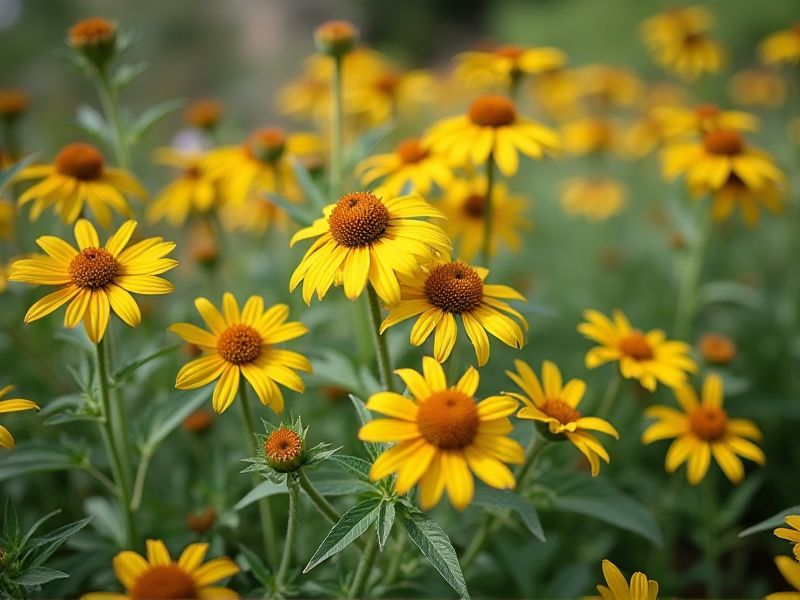
Drought-resistant plants, such as succulents and native grasses, possess unique adaptations that allow them to conserve water and endure arid conditions. Species like Agave and Aloe vera store moisture in their fleshy leaves, enabling survival during prolonged dry spells. Native grasses, such as buffalo grass, develop deep root systems that access underground moisture, making them ideal for xeriscaping. These plants not only require minimal irrigation but also contribute to ecological health by supporting local wildlife and preventing soil erosion. By incorporating drought-resistant plants into your garden, you can create a sustainable landscape that thrives even in challenging climates.
List of some Drought-resistant plants that thrive
- Lavender (Lavandula)
- Agave (Agave americana)
- Yucca (Yucca filamentosa)
- Purple Coneflower (Echinacea purpurea)
- Sagebrush (Artemisia tridentata)
- Lantana (Lantana camara)
- Sedum (Sedum spp.)
- Rosemary (Rosmarinus officinalis)
- Bladderpod (Cleome isomeris)
- Bougainvillea (Bougainvillea spectabilis)
Important things about Drought-resistant plants that thrive
Water-Efficient Root Systems
Drought-resistant plants boast exceptional water-efficient root systems that enable them to survive in arid conditions. These plants, such as succulents and certain native grasses, develop deep and extensive root networks that can access moisture from deeper soil layers, maximizing their hydration intake. Specialized adaptations, like thickened leaves or waxy coatings, further reduce water loss through evaporation, making them ideal for environments with limited water availability. When you cultivate drought-resistant plants in your garden, you not only conserve water but also enhance biodiversity and resilience in local ecosystems.
Thick, Waxy Leaves
Drought-resistant plants often feature thick, waxy leaves, which serve as a protective barrier to reduce water loss through transpiration. These adaptations help them endure prolonged dry spells, making them ideal for arid environments. Succulents, such as aloe vera and agave, showcase these characteristics and can store water in their leaves, allowing them to thrive with minimal rainfall. By incorporating these resilient plants into your landscape, you can create an attractive and sustainable garden that conserves water while showcasing vibrant greenery.
Deep Taproots
Drought-resistant plants, such as succulents and deep taproot species like mesquite trees, possess unique adaptations that enable them to thrive in arid conditions. These plants maximize water absorption by reaching deep underground moisture reserves, essential for survival in environments with limited rainfall. The deep taproots not only support hydration but also anchor the plants securely in the soil, preventing them from being uprooted by strong winds. By cultivating drought-resistant plants in your garden, you can create a sustainable landscape that conserves water while enhancing biodiversity.
Drought-Tolerant Adaptations
Drought-resistant plants exhibit remarkable adaptations that allow them to survive in arid conditions. Succulents, like agaves and aloes, store water in their tissues, enabling them to endure prolonged dry spells. Native grasses, such as buffalo grass and blue grama, develop deep root systems, accessing moisture from subterranean layers. You can enhance your garden's resilience by incorporating these drought-tolerant species, which require less maintenance and thrive in low water conditions.
Native Plant Varieties
Drought-resistant native plant varieties, such as Agave, Yucca, and Penstemon, are specifically adapted to arid environments, requiring minimal water while flourishing in direct sunlight. These plants possess deep root systems that allow them to access moisture stored in the soil, making them ideal for xeriscaping and sustainable gardening. Incorporating such resilient flora not only promotes biodiversity but also reduces the need for supplemental irrigation, conserving water resources. By selecting drought-tolerant natives, you can create a vibrant, low-maintenance landscape that supports local ecosystems while minimizing environmental impact.
Low Maintenance Requirements
Drought-resistant plants are ideal for enhancing water efficiency in gardens, especially in regions prone to arid conditions. Varieties such as lavender, succulents, and native grasses not only require minimal watering but also provide vibrant colors and textures to your landscape. When selecting these plants, consider their adaptability to local climates, as well as their ability to withstand extreme temperatures and limited moisture. Incorporating drought-resistant species into your garden can lead to reduced maintenance efforts and a more sustainable environment.
Reduced Transpiration Rates
Drought-resistant plants, such as succulents and cacti, exhibit reduced transpiration rates, allowing them to conserve water in arid environments. These adaptations include specialized leaf structures that minimize water loss and mechanisms to close stomata during hot, dry conditions. Many of these plants have deep root systems to access groundwater, enhancing their survival and growth. By incorporating drought-resistant varieties into your garden, you can create a sustainable landscape that requires less water and supports biodiversity.
Soil Moisture Retention
Drought-resistant plants possess specialized adaptations that enable them to efficiently retain soil moisture during arid conditions. Species such as succulents and xerophytes have evolved thick, fleshy leaves that store water, while their deep root systems tap into underground moisture reserves. Utilizing techniques like transpiration reduction, these plants minimize water loss and enhance their survival in low-water environments. Incorporating drought-resistant varieties in your garden not only conserves water but also promotes sustainable landscaping practices.
Resilience To Heat Stress
Drought-resistant plants, such as succulents and xerophytes, possess remarkable adaptations that enable them to thrive in arid conditions. These plants, including agave and cacti, feature specialized water-storage tissues and deep root systems that allow them to access moisture from the soil. Their leaf structures often minimize water loss through small stomata or waxy coatings, making them well-suited for extreme heat stress. By cultivating these resilient species in your garden, you can create a sustainable landscape that withstands fluctuating climates while conserving water resources.
Beneficial For Biodiversity
Drought-resistant plants, such as succulents and native grasses, play a pivotal role in enhancing biodiversity by thriving in arid environments. These resilient species conserve water and offer habitat and food sources for various pollinators and other wildlife. Planting drought-resistant varieties can significantly reduce water consumption in landscaping, promoting ecological balance in your garden. By incorporating these plants, you contribute to sustainable ecosystems that support diverse life forms and enhance soil stability.
